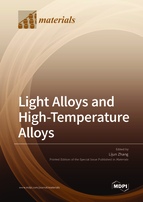Light Alloys and High-Temperature Alloys
A special issue of Materials (ISSN 1996-1944). This special issue belongs to the section "Metals and Alloys".
Deadline for manuscript submissions: closed (20 August 2022) | Viewed by 28025
Special Issue Editor
Interests: light alloys (Al-, Mg-); Ni-based super alloys; high-entropy alloys; CALPHAD; phase-field modeling; machine learning; alloy design
Special Issues, Collections and Topics in MDPI journals
Special Issue Information
Dear Colleagues,
Light alloys (Al-, Mg-, and Ti-based) and high-temperature alloys are widely used as key engineering materials in both civil and military industries due to their excellent comprehensive properties and performance. In order to meet the growing demand on the properties/performance of the materials, there is a perpetual need to explore novel light and high-temperature alloys. In this Special Issue of Materials, I would like to call for submission of papers on any new progress/development in the fields of light and high-temperature alloys. Both research and review articles are welcomed.
This Special Issue majorly covers all the theoretical and experimental investigations into different types of light alloys, including Al-, Mg-, and Ti-based, and high-temperature alloys, including Ni-, Co-, Fe-, and Nb-based. Either the mechanical or functional behaviors at all length scales can be emphasized. Related topics, like the protective coatings on high-temperature alloys, metal matrix composites, and so on, also fall within the scope of this Special Issue. Moreover, research on the new type of high-temperature alloys, i.e., high-entropy alloys, or multi-principal element alloys, are welcomed as well.
The deadline for all the submissions is 30 November 2021.
Thank you very much, and I look forward to receiving your submission soon!
Prof. Dr. Lijun Zhang
Guest Editor
Manuscript Submission Information
Manuscripts should be submitted online at www.mdpi.com by registering and logging in to this website. Once you are registered, click here to go to the submission form. Manuscripts can be submitted until the deadline. All submissions that pass pre-check are peer-reviewed. Accepted papers will be published continuously in the journal (as soon as accepted) and will be listed together on the special issue website. Research articles, review articles as well as short communications are invited. For planned papers, a title and short abstract (about 100 words) can be sent to the Editorial Office for announcement on this website.
Submitted manuscripts should not have been published previously, nor be under consideration for publication elsewhere (except conference proceedings papers). All manuscripts are thoroughly refereed through a single-blind peer-review process. A guide for authors and other relevant information for submission of manuscripts is available on the Instructions for Authors page. Materials is an international peer-reviewed open access semimonthly journal published by MDPI.
Please visit the Instructions for Authors page before submitting a manuscript. The Article Processing Charge (APC) for publication in this open access journal is 2600 CHF (Swiss Francs). Submitted papers should be well formatted and use good English. Authors may use MDPI's English editing service prior to publication or during author revisions.
Keywords
- light alloys (Al-, Mg-, and Ti-based)
- high-temperature alloys (Ni-, Co-, Fe-, and Nb-based)
- high-entropy alloys
- light/high-temperature alloy-based composites
- microstructure
- mechanical properties
- corrosion and oxidation
- phase equilibrium and diffusion
- alloy design
- integrated computational materials engineering







